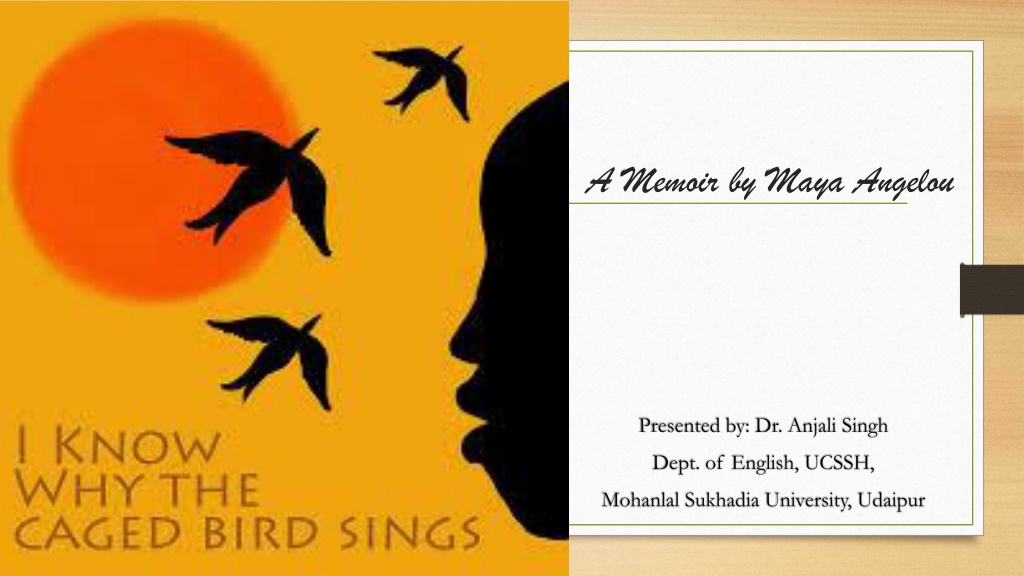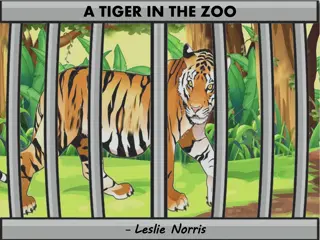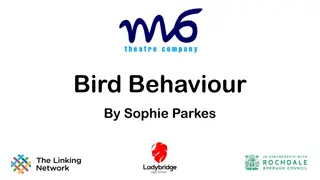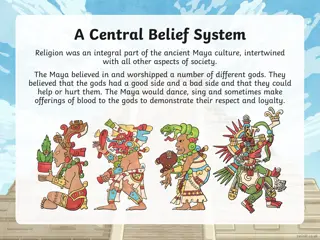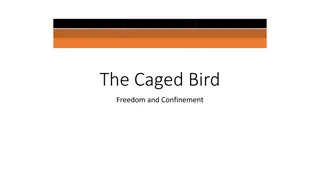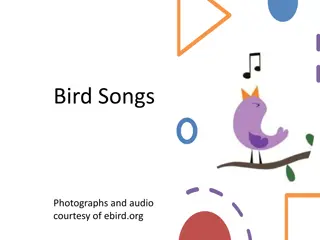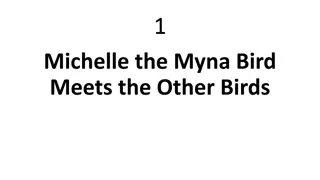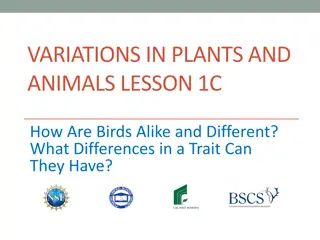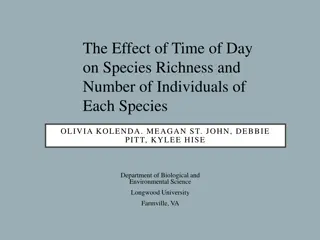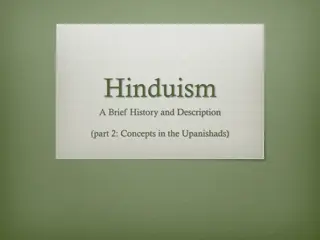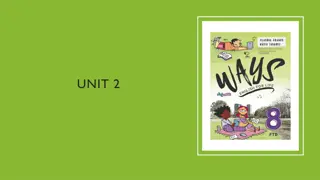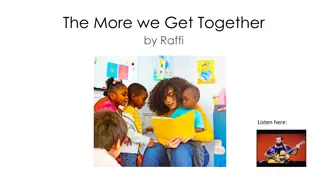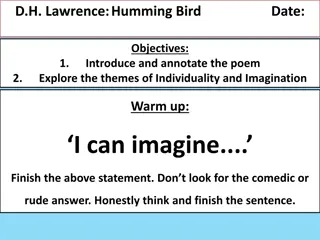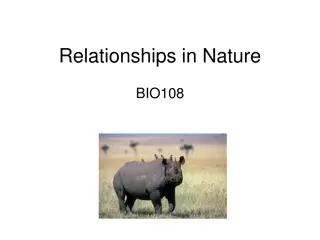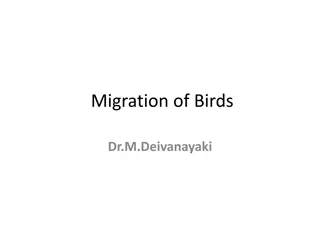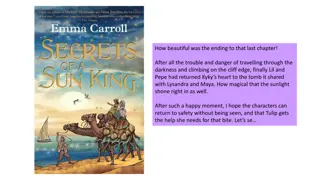I Know Why the Caged Bird Sings: Maya Angelou's Memoir Journey
The memoir "I Know Why the Caged Bird Sings" by Maya Angelou recounts her tumultuous early years, including experiences of racism, rape, and resilience. The story follows Maya and her brother as they navigate familial challenges, discrimination, and personal growth from Arkansas to St. Louis and San Francisco. Through vivid storytelling, Angelou explores themes of identity, trauma, and the enduring power of the human spirit.
Uploaded on Oct 06, 2024 | 0 Views
Download Presentation

Please find below an Image/Link to download the presentation.
The content on the website is provided AS IS for your information and personal use only. It may not be sold, licensed, or shared on other websites without obtaining consent from the author. Download presentation by click this link. If you encounter any issues during the download, it is possible that the publisher has removed the file from their server.
E N D
Presentation Transcript
A Memoir by Maya Angelou Presented by: Dr. Anjali Singh Dept. of English, UCSSH, Mohanlal Sukhadia University, Udaipur
Background I Know Why the Caged Bird Sings is the first of seven autobiographical works by American writer Maya Angelou. It was published in 1969 and charts her life from age 3 up to age 16. Her memoir recounts an unsettled childhood that included rape and racism. Her memoir is counted among one of the most widely read and taught books written by an African-American woman.
What is a Memoir? A non-fiction narrative written about an important event in the author s life Often a life-changing event Written in first-person Different from an autobiography which details the events in a person s life chronologically Memoir is restricted to a single event or interconnected series of a single event It has a narrower focus than an autobiography The event/s in a memoir are considered to be factually true
Summary Part I The story begins in 1931, as Maya, aged three, and her elder brother, Bailey, are sent to Stamps, Arkansas, to live with their paternal grandmother, Momma, after their parents divorce. Momma owns the only store in the African-American part of Stamps. The children help her at the store and learn to do arithmetic. One night a former sheriff warns Momma to hide her disabled son, Uncle Willie because white men of the Ku Klux Clan are planning revenge after a Black man messed with a white woman. Maya describes her days around the economic activity of the Cotton Pickers. When the Great Depression comes, Momma keeps the store running by allowing her customers to exchange goods for their rations. One Christmas, Maya and Bailey receive gifts from their parents. A year later their father, Daddy Bailey, arrives in a fancy car, and he takes Maya and Bailey to St. Louis to live with their mother, Vivian.
Summary Part II In San Francisco, Maya and Bailey stay with Vivian s mother and their uncles. At school, Maya and her brother are more advanced than the other students, and they are moved up a grade. Vivian takes the children to live with her and her boyfriend, Mr. Freeman. Mr. Freeman begins molesting eight-year-old Maya, threatening to kill Bailey if she tells anyone. One day he finally rapes her, and she hides her stained underwear under the mattress. When changing the linens, Bailey and Vivian find the garment and realize what happened. The truth is revealed and Mr. Freeman is arrested. During Mr. Freeman s trial, Maya lies when asked whether he had ever touched her before the rape. Later, Mr. Freeman is beaten to death in prison. Maya feels guilty and blames herself. She stops speaking to anyone except Bailey. After a few months of her silence, Vivian decides to send Maya and Bailey back to Momma.
Summary Part III Maya is happy to be back with Momma, but she continues her silence. Eventually, Mrs. Bertha Flowers takes Maya under her wing, telling her that it is important to speak and by making her read books aloud, she gets Marguerite to start talking again. At the age of 10, Maya is sent to work for a white woman, who calls her Mary rather than her name (Marguerite). Offended, Maya breaks some china in order to get fired. Later, Bailey is upset when he sees a movie starring Kay Francis because he thinks the actress looks just like his mother, Vivian, and he makes an unsuccessful attempt to return to his mother. During this time, Maya continues to encounter racism. When she develops cavities, Momma takes her to the white dentist who borrowed money from Momma during the Depression, but he refuses to treat the child, and they have to take a bus to the closest Black dentist. Bailey sees the decaying corpse of a Black man pulled out of a pond, and a white man forces him to him help carry the body away. After this incident, Momma decides to take Maya and Bailey back to their mother.
Summary Part IV Maya and Bailey move with their mother to Oakland, California. Maya attends a school in which she is one of only three Black students. When she is 14 years old, she is awarded a scholarship to the California Labor School, where she studies drama and dance. Vivian s new husband, Daddy Clidell, proves to be a genuine father figure for Maya. Maya spends a summer in southern California with Daddy Bailey and his girlfriend, Dolores. Dolores and Maya do not get along. Daddy Bailey and Dolores argue, and he walks out. Maya tries to console Dolores, but Dolores insults Vivian, leading Maya to slap her. Dolores then cuts Maya, who decides to run away. After spending a night in a junkyard, she awakens to find a community of Black, white, and Mexican runaways living there. She stays for a month and then returns to Vivian.
Summary - V In the meantime, Bailey has become friends with a group of slick street boys and begun dating a white prostitute. At the age of 16 he leaves hom. Maya gets the transit company to hire her as the first female African-American streetcar conductor in San Francisco. However, after spending one semester at the job, she returns to school. She later reads the lesbian novel The Well of Loneliness (1928) by Radclyffe Hall, and, misunderstanding what lesbianism is, she begins to fear that she might be a lesbian. Though Vivian tries to reassure her, she is not assuaged, and she determines to have sex with a boy. The unpleasant encounter results in Maya s becoming pregnant. On Bailey s advice, she keeps the news to herself and returns to school. After graduating from high school, Maya tells Vivian and Daddy Clidell, who are fully supportive. After her baby, Guy, is born, Vivian assures Maya that she will be a good mother.
Themes: Racism Against the backdrop of racial tensions in the American South, Angelou confronted the traumatic events of her childhood and explored the evolution of her strong identity as an African-American woman. The book draws the reader s attention to the Black people in America and their struggle with racism and segregation. Maya Angelou confronted the insidious effects of racism and segregation in America at a very young age. She internalizes the idea that blond hair is beautiful and that she is a fat black girl trapped in a nightmare.
Themes: Segregation Stamps, Arkansas, is so thoroughly segregated that as a child Maya does not quite believe that white people exist. Interestingly, othering is practiced by both, the white and the black people. As she grows, Maya is confronted by more overt incidents of racism, such as a white speaker s condescending address at her eighth-grade graduation, her white boss s insistence on calling her Mary, and a white dentist s refusal to treat her. The importance of Joe Louis s world championship boxing match to the black community reveals the sheer lack of publicly-recognized African-American heroes. It also brings to light, the desperation of the black community, which hopes to vindicate itself through his win. The memoir also reveals how life in a racist society profoundly shapes her character, as well as that of her community.
Themes: Displacement Maya, like other children in African-American families, changes seven different homes before she turns sixteen. She moves from California to Stamps to St. Louis to Stamps to Los Angeles to Oakland to San Francisco to Los Angeles to San Francisco. Her poetry recitation on Easter states, Ididn t come to stay . This becomes the Mantra against the harsh reality of her rootlessness. She is unable to put down her worries and feel comfortable staying in one place. When she is thirteen and moves to San Francisco with her mother, Bailey, and Daddy Clidell, she feels that she belongs somewhere for the first time. Maya identifies with the city as a town full of displaced people. Maya s personal displacement is representative of the societal forces that displaced African-Americans all across the country. When she wrote and published her book in 1969, Angelou pointed out that African-Americans descended from slaves were first displaced from their homes and homelands in Africa. Despite the Emancipation Proclamation Bill of 1862, blacks continue to struggle to find their place in a country still hostile to their heritage. Cut to 2020, the media is supporting the voice of #blacklivesmatter
Minor Themes The Great Depression The Second World Was Japanese Internment Camps Ku Klux Clan Othering Race
Questions How does Marguerite change from when the book begins and ends in I Know Why the Caged Bird Sings? How are the themes of racism and segregation incorporated in the book? Marguerite and Bailey face displacement throughout their early years. How does displacement affect them? Is the displacement in the memoir merely physical displacement? Elucidate your reply with suitable illustrations from the memoir.
